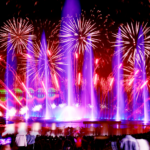The Mausoleum of the Chu King on Lion Mountain is located 4 kilometers east of Xuzhou urban area and is an essential scenic spot in the Han culture scenic area. The 54.3-meter-high Lion Mountain is almost hollowed out, and the grandeur of the mausoleum is evident. Various clues also show that this tomb was not completed. The identity of the tomb owner is a bit mysterious. It may be Liu Wu, the third-generation Chu King of the Western Han Dynasty (still controversial).
After being defeated in the Rebellion of the Seven Kingdoms, he committed suicide in a hurry to avoid implicating his family and was buried hastily. If you are a fan of Han culture or a ‘tomb raiding’ enthusiast, you might as well come here to explore. Entering from the south gate of the Han culture scenic area is the Mausoleum of the Chu King on Lion Mountain. In front of the tomb stands a statue of the Chu King riding a war horse. The tomb runs from south to north. Entering the tomb, the first thing you see is the outer tomb passage in the south, which is 27.6 meters long and slightly wider than the subsequent tomb passages. Continuously going down along the steps, where the walls on both sides suddenly narrow to form a ‘narrow strip of sky’, is the middle tomb passage. The middle tomb passage is 20.3 meters long. On the east side, there is a tomb of a close minister who served the Chu King’s diet buried as a sacrifice. Continuing northward is the inner tomb passage, which is 19.3 meters long. The patio above leads to the top of the mountain. In those days, craftsmen dug in from the patio to build the Mausoleum of the Chu King. There are three side chambers on both sides of the inner tomb passage. The side chamber on the east is the kitchen, with two doors. It is the largest of all the tombs. You can see ancient kitchenware replicas placed inside. The side chamber on the west and south is the Yufuku where ritual vessels and weapons are stored. Exquisite gold buckles have been unearthed here. The side chamber on the west and north is the Yufuku where bathing utensils are placed. Moving forward, you can see the main tomb door. To prevent tomb raiding, it was sealed with 16 blocking stones. Although the previous three side chambers were spared, the remaining tombs behind the main tomb door were still robbed. It is speculated that it was a large-scale official tomb robbery around the time when Wang Mang usurped the throne (around 8 AD). Behind the main tomb door is the corridor leading to the main tomb chamber. It is 33.8 meters long. There are six side chambers on both sides, namely the money storehouse, the Yufuku for daily utensils, the Yufuku for official seals and goldware of the Chu Kingdom, and the tombs of concubines buried as sacrifices. At the end of the corridor is the front hall, that is, the main tomb chamber. Originally, a very rare jade-inlaid coffin was placed on the east side. When the Mausoleum of the Chu King was excavated, a jade burial suit sewn with gold thread was unearthed in the main tomb chamber. It was made of more than 4,000 high-quality Hetian jade pieces. Unfortunately, the gold threads were taken away by tomb robbers. Of course, the coffins and jade burial suits seen in the tomb chamber now are all replicas. Finally, reaching the back chamber at the northern end, be sure to pay attention to the rough excavation marks here, which are strong evidence that the mausoleum was not completed. In the center of the back chamber stands a statue of the Chu King restored according to the remains of the Chu King. On both sides are placed replicas of chime bells and stone chimes unearthed here. It is speculated that this may be a music and dance hall.After visiting the Lion Hill Chu King’s Tomb, you may also explore the Han Cultural Scenic Area, which includes the Han Terracotta Warriors Museum, the Submerged Terracotta Warriors Museum, and the Han Painting Gallery. Together with the Chu King’s Tomb, they are known as the ‘Three Wonders of the Han Dynasty’.
Since the artifacts in the Lion Hill Chu King’s Tomb are replicas, if you seek authenticity, consider visiting the Xuzhou Museum where you can view many genuine relics from tombs.
Opening hours: 08:30 to 17:00 from April 1st to October 31st; 08:30 to 16:30 from November 1st to March 31st.










